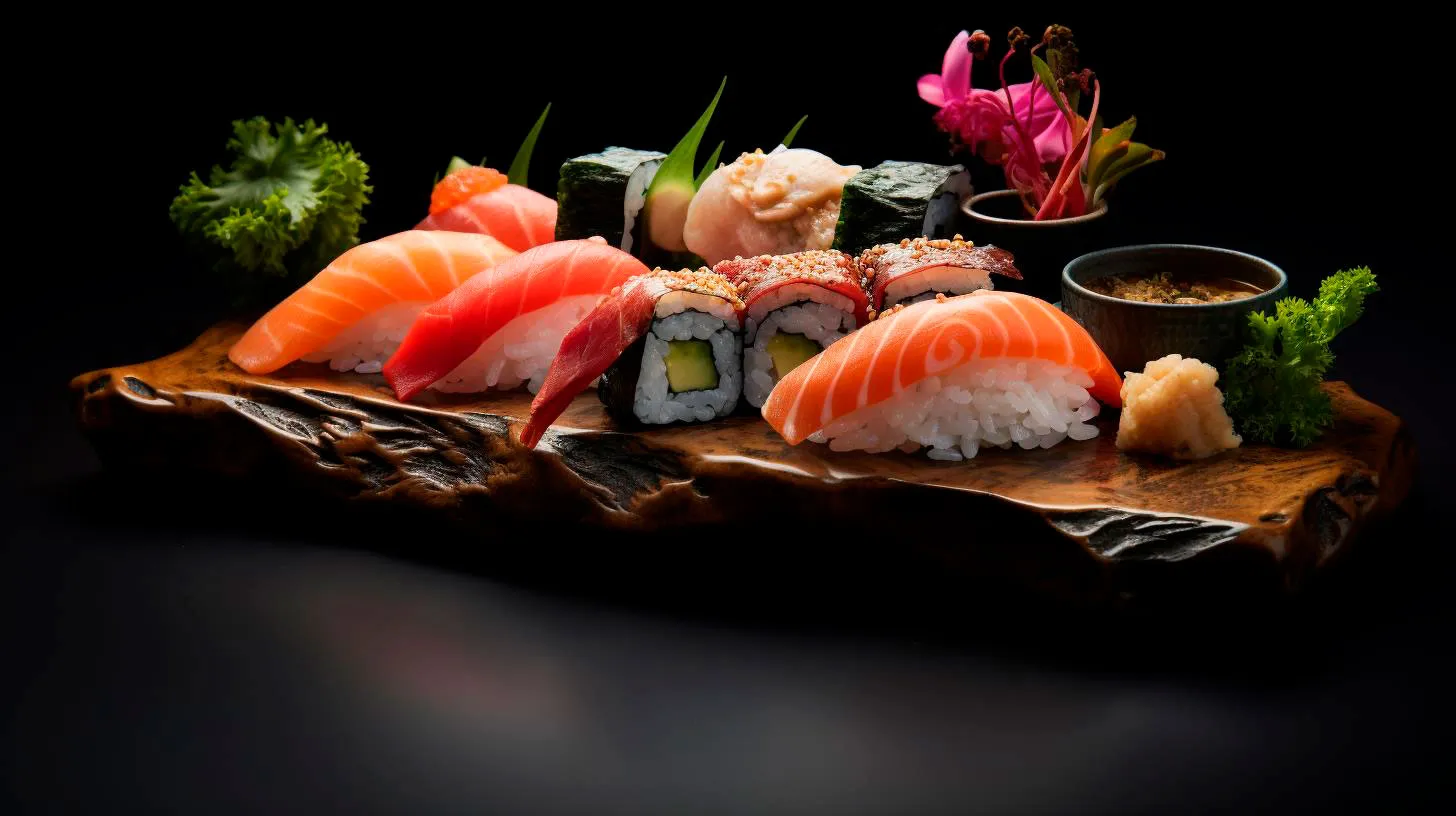From Vinegar to Sugar: Unlocking the Secrets of Sushi Rice Seasoning
The answer lies in the art of sushi rice seasoning. In this article, we will delve into the fascinating world of sushi rice seasoning, from the traditional ingredients used to the key techniques that elevate it to perfection.
Understanding Sushi Rice
Before we dive into the intricate process of sushi rice seasoning, let’s first understand what sets sushi rice apart from ordinary rice. Sushi rice, also known as shari, is a short-grain, sticky rice variety that is specifically cultivated for sushi making. This unique grain is starchier than regular rice, which gives sushi its characteristic texture and allows it to hold its shape when rolled into delicious sushi rolls.
The Role of Sushi Rice Seasoning
While the quality and freshness of the fish are vital components of exceptional sushi, the secret behind a truly memorable sushi experience lies in the seasoning of the rice. Sushi rice seasoning is responsible for infusing flavor, texture, and balance to each bite. Traditionally, sushi rice is seasoned with a combination of rice vinegar, sugar, and salt. Let’s explore each element of this magical trio:
- Rice Vinegar: Rice vinegar serves as the primary seasoning agent for sushi rice. It infuses a tangy and slightly sweet flavor that complements the other ingredients. The acidity of the vinegar also helps to balance the richness of the fish.
- Sugar: The addition of sugar provides a delicate sweetness that counteracts the sharpness of the vinegar. It helps to round out the flavors and enhances the overall taste profile of the sushi.
- Salt: Salt acts as a flavor enhancer, bringing out the natural tastes of the rice and other ingredients. It also helps to control the fermentation process and preserve the rice.
The Technique Behind Sushi Rice Seasoning
Seasoning sushi rice may seem like a simple task, but mastering the technique takes time and practice. Here are the key steps to follow:
- Start by cooking the sushi rice according to the instructions on the package.
- In a small saucepan, heat the rice vinegar, sugar, and salt over low heat, stirring until the sugar and salt dissolve completely.
- Transfer the cooked rice to a wooden or non-metallic bowl. Pour the vinegar mixture over the rice while it is still hot.
- With a wooden spatula or rice paddle, gently fold the vinegar mixture into the rice using a cutting and folding motion. Be careful not to smash or break the grains.
- Continue to fold the rice until the vinegar mixture is evenly distributed and each grain is coated.
- Cover the seasoned rice with a damp cloth to prevent it from drying out. Let it cool to room temperature before using it for sushi preparation.
Tips for Perfect Sushi Rice Seasoning
Now that you know the basics of sushi rice seasoning, here are some expert tips to help you achieve restaurant-quality results:
- Use high-quality rice vinegar to ensure the best flavor.
- Adjust the ratio of vinegar, sugar, and salt to suit your taste preferences.
- Avoid using metal utensils when working with sushi rice, as they can react with the vinegar and alter the taste.
- Allow the seasoned rice to cool naturally, as using a fan or refrigerating it may result in an uneven texture and affect the overall taste.
- For added flavor, consider experimenting with variations like adding a touch of mirin (sweet rice wine) or kombu (kelp) to the vinegar mixture.
Unlocking the Secrets of Sushi Rice Seasoning
The art of sushi rice seasoning is not to be underestimated. It holds the power to elevate ordinary sushi to extraordinary levels. By understanding the role of rice vinegar, sugar, and salt, and mastering the technique behind sushi rice seasoning, you can unlock the secrets to creating sushi that is worthy of the finest sushi bars in Japan.
Incorporate these key takeaways into your sushi-making journey:
- Sushi rice seasoning is the secret behind flavorful and well-balanced sushi.
- The traditional combination of rice vinegar, sugar, and salt creates the perfect harmony of flavors.
- Master the technique of folding the vinegar mixture into the rice to ensure even distribution.
- Experiment with variations of the seasoning to add your personal touch to sushi rice.
With these insights, you are now ready to embark on a culinary adventure, unraveling the secrets of sushi rice seasoning. Prepare to impress your friends and family with homemade sushi that rivals the finest sushi restaurants!
The Perfect Texture Tips and Techniques for Cooking Sushi Rice
In this article, we will explore the tips and techniques to achieve the perfect texture for cooking sushi rice.
The Importance of Sushi Rice Texture
The texture of sushi rice plays a crucial role in the overall taste and enjoyment of sushi. When cooked to perfection, sushi rice should be sticky enough to hold the ingredients together while still retaining an individual grain structure. Achieving this ideal texture requires careful attention to various factors during the cooking process.
Key Techniques for Cooking Sushi Rice
1. Selection of Rice
Choosing the right type of rice is vital for successful sushi rice. Short-grain varieties like Japanese sushi rice or Calrose rice are preferred due to their high starch content, which contributes to the desired stickiness. Avoid long-grain or basmati rice as they have a drier texture that is not suitable for sushi.
2. Washing and Soaking
Before cooking the rice, it’s essential to wash it thoroughly to remove any excess starch that can make the rice clumpy. Rinse the rice under cold water until the water runs clear. After washing, soak the rice for about 30 minutes to ensure even cooking and achieve the desired texture.
3. Water-to-Rice Ratio
The appropriate water-to-rice ratio is a crucial factor in achieving the perfect texture. Generally, using one and a half cups of water for every cup of rice works well. It’s important to accurately measure the ingredients to maintain consistency in texture and taste.
4. Cooking Method
Traditionally, sushi rice is cooked using a stovetop method. After rinsing and soaking the rice, bring it to a boil in a covered pot and then reduce the heat to low. Allow the rice to simmer for about 15-20 minutes until all the water is absorbed. Once cooked, let the rice rest for 10 minutes before fluffing it gently with a fork or rice paddle.
5. Vinegar Mixture
To achieve the characteristic tangy flavor of sushi rice, it is important to season it with a vinegar mixture. Combine rice vinegar, sugar, and salt in a separate bowl and heat it until the sugar dissolves. Gently and evenly fold this mixture into the cooked rice while it is still warm.
The Advantages of Perfectly Cooked Sushi Rice
- Enhances the overall taste of sushi:
- Improved rolling and shaping:
- Professional presentation:
- Authenticity and appreciation:
Achieving the perfect texture in sushi rice ensures that each bite of sushi offers a delightful combination of flavors, making the dish more enjoyable for sushi enthusiasts.
Sticky sushi rice binds the ingredients together, allowing for easier rolling and shaping of sushi rolls, nigiri, and other sushi varieties. Perfectly cooked rice ensures the structural integrity of sushi.
Having the right texture in sushi rice enables chefs to create visually appealing sushi presentations. When the rice holds its shape and maintains a glossy appearance, it enhances the overall aesthetic appeal of the sushi dish.
Mastering the art of cooking sushi rice with the perfect texture brings authenticity to your homemade sushi. It showcases your dedication to the craft and allows others to appreciate the traditional flavors and textures of sushi.
Key Takeaways
Aspiring sushi enthusiasts should pay close attention to achieving the perfect texture for cooking sushi rice. The selection of the right rice, proper washing and soaking methods, maintaining the water-to-rice ratio, employing suitable cooking methods, and seasoning with vinegar are all critical steps. With the ideal texture, sushi rice enhances the taste, improves presentation, and allows for easy rolling and shaping of sushi. Mastering these techniques will bring your sushi-making skills to the next level, impressing both yourself and your guests.
The Essential Elements Mastering the Art of Sushi Rice
In this article, we will delve into the essential elements of mastering the art of sushi rice.
A Perfect Balance of Ingredients
The key to achieving the perfect sushi rice lies in the delicate balance of its ingredients. Traditionally, sushi rice is made by combining premium Japanese short-grain rice with rice vinegar, sugar, and salt. The ratios may vary slightly depending on personal taste preferences, but a common rule of thumb is to use one part rice vinegar, one part sugar, and one part salt for every five parts of cooked rice.
By using high-quality ingredients and mastering the right proportions, you’ll be able to create a sushi rice that is both flavorful and properly seasoned. The vinegar should add a tangy and slightly sweet taste, while the salt enhances the overall flavor profile. This balanced combination ensures that the rice harmonizes with the fish and other sushi ingredients, allowing the flavors to shine.
The Careful Art of Rice Cooking
Preparing sushi rice involves more than merely cooking rice in a pot of boiling water. It requires a careful and precise technique to achieve the desired sticky yet fluffy texture. Here are some key steps to consider:
- Washing the Rice: Rinse the rice gently in cold water to remove excess rice starch. Repeat this process several times until the water runs clear.
- Soaking the Rice: Allow the washed rice to soak for approximately 30 minutes. This step helps the rice absorb water evenly and cook more uniformly.
- Proper Water-to-Rice Ratio: The ratio of water to rice is critical in achieving the perfect texture. Generally, a ratio of 1:1 is used, meaning equal parts of water and rice. However, some variations in ratios may depend on the specific type of rice used.
- Cooking Method: Traditionally, sushi rice is cooked using a stovetop pot. However, rice cookers are commonly used nowadays for convenience and consistent results.
- Simmering and Resting: Once the rice is cooked, let it rest for about 10-15 minutes, allowing it to steam and set.
The Importance of Proper Sushi Rice Handling
Handling sushi rice is a crucial element in mastering the art of sushi. Once the rice is cooked, it is important to handle it with care to preserve its texture and flavor. Here are a few key tips:
- Cooling the Rice: After cooking, transfer the sushi rice to a wooden or non-reactive bowl and gently cool it down with a fan or fanning technique. This helps remove excess moisture and prevent the rice from becoming mushy.
- Avoid Overmixing: When seasoning the rice with the vinegar mixture, use a wooden spatula or rice paddle to gently fold and mix the rice. Avoid vigorous stirring, as this can result in a pasty consistency.
- Keep It Covered: To prevent the rice from drying out or becoming too sticky, cover it with a damp cloth or plastic wrap while preparing other sushi ingredients.
Key Takeaways
Mastering the art of sushi rice involves a careful blend of high-quality ingredients and precise cooking techniques. Here are some key takeaways to remember:
- The balance of vinegar, sugar, and salt is crucial in achieving flavorful sushi rice.
- Washing and soaking the rice before cooking helps remove excess starch and ensures even cooking.
- The proper water-to-rice ratio and cooking method are vital for achieving the ideal texture.
- Carefully handling the cooked rice preserves its texture and flavor.
By giving equal attention to the sushi rice alongside the fish and other ingredients, you can elevate your sushi-making skills to new heights. Remember, the perfect sushi experience starts with the perfect sushi rice!
Sushi Rice Varieties: Exploring the Different Grains
When it comes to sushi rice, there isn’t just one type. Various rice varieties are used, each offering its unique taste, texture, and aroma. In this article, we will delve into different sushi rice varieties and explore the grains that make each one special.
1. Short-Grain Rice
Short-grain rice is the most commonly used variety for sushi making. It is known for its sticky texture and sweet flavor, which perfectly complements the freshness of the fish. Short-grain rice absorbs the vinegar-based seasoning well, ensuring a well-balanced sushi roll. Its stickiness allows it to hold its shape, making it ideal for nigiri or sushi rolls.
Key advantages:
- Sticky texture enhances the holding capacity of sushi rolls and nigiri.
- Sweet flavor complements the taste of the toppings and fillings.
- Easy to shape and mold.
2. Medium-Grain Rice
Medium-grain rice is another popular choice for sushi. It is slightly longer and less sticky than short-grain rice, but still provides a pleasant texture and absorbs flavors well. This variety of rice delivers a slightly firmer bite and a more distinct grain separation. It works well for hand rolls, sushi bowls, and any dish where a less sticky consistency is desired.
Key advantages:
- Less sticky, but still holds flavors and shape well.
- Distinct grain separation provides a visually appealing presentation.
- Great for sushi bowls and hand rolls.
3. Koshihikari Rice
Koshihikari rice is a premium variety known for its exceptional taste and texture. It is highly prized in Japan and commonly used for sushi due to its delicate and slightly sweet flavor. Koshihikari rice has a plump yet sticky consistency, making it perfect for sushi rolls and nigiri. Its superior quality elevates the overall sushi dining experience.
Key advantages:
- Exceptional taste and delicate flavor.
- Plump and sticky texture enhances sushi roll preparation.
- High-quality rice ideal for special occasions.
4. Calrose Rice
Calrose rice, originating from California, has gained popularity as a sushi rice option. It is a medium-grain rice with a slightly chewy texture and subtle flavor. Calrose rice absorbs flavors well and provides a pleasing mouthfeel when combined with other sushi ingredients. It is often chosen for sushi bowls, poke bowls, and everyday sushi rolls.
Key advantages:
- Chewy texture adds a pleasant mouthfeel to the dish.
- A versatile option for everyday sushi creations.
- Affordable and widely available.
Key Takeaways
Choosing the right rice variety is crucial for creating an extraordinary sushi experience. Whether you prefer the sweetness of short-grain rice, the distinct grain separation of medium-grain rice, the delicate flavor of Koshihikari rice, or the versatility of Calrose rice, there is a sushi rice variety to suit every palate.
Remember, sushi rice is not just a side ingredient but an essential element that defines the taste, texture, and overall enjoyment of sushi. Experiment with different rice varieties and explore the unique grains that make each sushi roll a delectable masterpiece.
So, next time you embark on a sushi adventure, pay attention to the rice selection and appreciate the craftsmanship that goes into preparing the perfect sushi rice.


